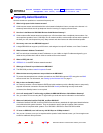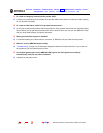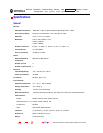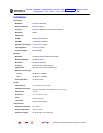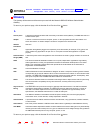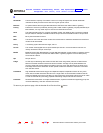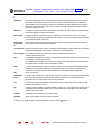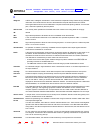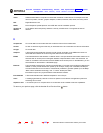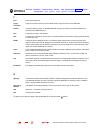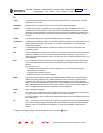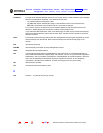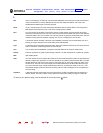
132 SBG1000 Wireless Cable Modem Gateway User Guide
Home
X
ExitPrint
Overview Installation Troubleshooting Contact FAQ Specifications Glossary License
Configuration: Basic Gateway TCP/IP Wireless Print Server USB
D
datagram In RFC 1594, a datagram is defined as “a self-contained, independent entity of data carrying sufficient
information to be routed from the source to the destination computer without reliance on earlier
exchanges between this source and destination computer and the transporting network.” For the most
part, it has been replaced by the term packet.
default route The route by which packets are forwarded when other routes in the routing table do not apply.
dB decibel
dBc Signal level expressed in dB relative to the unmodulated carrier level desired.
DBm A unit of measurement referenced to one milliwatt across specified impedance. 0dBm = 1 milliwatt
across 75 ohms.
dBmV Signal level expressed in dB as the ratio of the signal power in a 75-ohm system to a reference power
when 1 mV is across 75 ohms.
demodulation An operation to restore a previously modulated wave and separate the multiple signals that were
combined and modulated on a subcarrier.
DHCP A Dynamic Host Configuration Protocol server dynamically assigns IP addresses to client hosts on an
IP network. DHCP eliminates the need to manually assign static IP addresses by “leasing” an
IP address and subnet mask to each client. It enables the automatic reuse of unused IP addresses:
The SBG1000 is simultaneously a DHCP client and a DHCP server.
• A DHCP server at the cable system headend assigns a public IP address to the
SBG1000 and
optionally to clients on the SBG1000 LAN.
• The SBG1000 contains a built-in DHCP server that assigns private IP addresses to clients.
distortion An undesired change in signal waveform within a transmission medium. A nonlinear reproduction of
the input waveform.
diversity
antennas
Two identical antennas located a small distance apart to reduce multipath distortion and improve
wireless reception. Properly placed diversity antennas improve SBG1000 wireless reception.
DNS The Domain Name System is the Internet system for converting domain names to IP addresses. A
DNS server contains a table matching domain names such as Internetname.com to IP addresses
such as 192.169.9.1. When you access the world-wide web, a DNS server translates the URL
displayed on the browser to the destination website IP address. The DNS lookup table is a distributed
Internet database; no one DNS server lists all domain name to IP address matches.
DOCSIS The CableLabs Data-Over-Cable Service Interface Specification defines interface standards for cable
modems, gateways, and supporting equipment to deliver data between an HFC network and a
computer systems or television sets. To emphasize its use as a cable modem standard, DOCSIS is
now called CableLabs Certified Cable Modems. Euro-DOCSIS is DOCSIS adapted for use in Europe.
domain name A unique name, such as motorola.com, that maps to an IP address. Domain names are typically much
easier to remember than are IP addresses.
dotted-decimal
format
Method of representing an IP address or subnet mask using four decimal numbers called octets. Each
octet represents eight bits.
In a class C IP address, the octets are “network.network.network.host.” The first three octets together
represent the network address and the final octet is the host address. In the SBG1000 LAN default
configuration, 192.168.100 represents the network address. In the final octet, the host address can be
from 2 to 254.
download To copy a file from one computer to another. You can use the Internet to download files from a server
to a computer. A DOCSIS or Euro-DOCSIS cable modem or gateway downloads its configuration file
from a TFTP server during start-up.
downstream In a cable data network, the direction of data received by the computer from the Internet.




